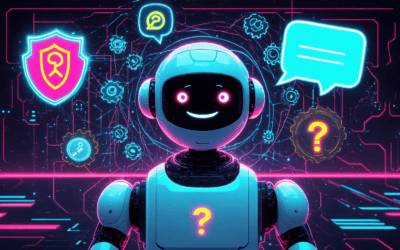In an era of digital transformation, smart chatbots are revolutionizing customer service and redefining AI-powered interactions. These intelligent virtual assistants, powered by advanced artificial intelligence and machine learning algorithms, are transforming the way businesses engage with their customers. From simple rule-based systems to sophisticated conversational AI like ChatGPT, smart chatbots have evolved to handle complex queries, provide personalized recommendations, and even learn from each interaction. This article delves into the world of smart chatbots, exploring their types, development processes, and applications across various platforms, including Android and iOS. We’ll uncover the key differences between simple and smart chatbots, examine voice-enabled assistants like Alexa, and look at how businesses can leverage free smart chatbot options to enhance their customer service strategies.
Understanding Smart Chatbots
In today’s digital landscape, smart chatbots have become an integral part of customer interaction strategies. These AI-powered virtual assistants are revolutionizing the way businesses communicate with their audience, offering seamless and efficient conversational experiences. As a leader in this field, we at Messenger Bot are at the forefront of developing intelligent chatbot solutions that transform customer engagement.
What is a smart chatbot?
A smart chatbot is an advanced artificial intelligence program designed to simulate human-like conversations through text or voice interactions. Unlike their simpler counterparts, smart chatbots leverage machine learning algorithms and natural language processing to understand context, learn from interactions, and provide more accurate and personalized responses over time.
These sophisticated bots go beyond pre-programmed responses, offering dynamic conversations that can handle complex queries, perform tasks, and even anticipate user needs. At Messenger Bot, we’ve harnessed this technology to create chatbots that not only respond to user inquiries but also optimize the customer experience through continuous learning and adaptation.
Evolution of AI-powered virtual assistants
The journey of virtual assistants has been nothing short of remarkable. From basic rule-based chatbots to today’s intelligent conversational AI, the evolution has been driven by advancements in artificial intelligence and natural language understanding. Early chatbots were limited to simple keyword matching and predefined responses, often frustrating users with their inability to comprehend context or handle complex queries.
However, the integration of machine learning and deep learning techniques has given rise to a new generation of virtual assistants capable of understanding nuanced language, recognizing intent, and even detecting sentiment. This evolution has enabled chatbots to handle increasingly sophisticated tasks, from boosting online sales to providing personalized customer support across multiple channels.
At Messenger Bot, we’ve embraced this evolution, continuously refining our AI algorithms to create chatbots that not only understand user queries but also engage in meaningful, context-aware conversations. Our platform leverages the latest advancements in AI to offer businesses a powerful tool for elevating customer support and driving engagement across various digital touchpoints.

The Pinnacle of Chatbot Technology
As we delve deeper into the world of smart chatbots, it’s crucial to explore the cutting-edge advancements that have propelled this technology to new heights. At Messenger Bot, we’re constantly pushing the boundaries of what’s possible in conversational AI, striving to offer our users the most sophisticated chatbot experiences available.
What is the smartest chatbot ever?
The quest for the smartest chatbot is an ongoing journey in the field of artificial intelligence. While it’s challenging to crown a single chatbot as the absolute smartest, several contenders have made significant strides. ChatGPT, developed by OpenAI, has garnered widespread attention for its remarkable language understanding and generation capabilities. However, other notable mentions include IBM Watson and Google’s LaMDA.
At Messenger Bot, we’ve developed our own advanced AI chatbot that rivals these industry giants in many aspects. Our bot utilizes state-of-the-art machine learning algorithms to provide intelligent, context-aware responses across multiple languages, making it a formidable contender in the smart chatbot arena.
ChatGPT: Revolutionizing conversational AI
ChatGPT has undeniably revolutionized the landscape of conversational AI. Its ability to understand context, generate human-like responses, and adapt to various tasks has set a new standard in the industry. This AI-driven chatbot has demonstrated proficiency in areas ranging from creative writing to problem-solving, showcasing the immense potential of language models in enhancing user interactions.
While ChatGPT has made waves, it’s important to note that other platforms, including our own Messenger Bot, are continuously evolving to offer comparable or even superior capabilities. Our AI-powered customer service bots leverage similar advanced language processing techniques to deliver personalized, efficient, and engaging conversations across various channels.
As we continue to innovate in the realm of smart chatbots, our goal at Messenger Bot is to harness the power of AI to create virtual assistants that not only match but exceed the capabilities of current industry leaders. By focusing on multilingual support and seamless integration with popular platforms, we’re committed to providing businesses with chatbot solutions that truly revolutionize customer interactions.
III. Developing Intelligent Chatbots
As the demand for smart chatbots continues to grow, businesses and developers are seeking ways to create their own intelligent virtual assistants. Developing a smart chatbot requires a combination of natural language processing (NLP), machine learning, and artificial intelligence techniques. Let’s explore how to make a smart chatbot and delve into some Python tutorials for chatbot development.
A. How to make a smart chatbot?
Creating a smart chatbot involves several key steps:
- Define the purpose: Determine the specific tasks and goals your chatbot will accomplish.
- Choose a platform: Select a chatbot development platform or framework that aligns with your needs and technical expertise.
- Design the conversation flow: Map out the potential user interactions and create a logical conversation structure.
- Implement NLP: Integrate natural language processing capabilities to understand and interpret user inputs accurately.
- Train the AI model: Use machine learning algorithms to train your chatbot on relevant data sets, improving its responses over time.
- Test and refine: Continuously test your chatbot and refine its responses based on user feedback and performance metrics.
At Messenger Bot, we offer a sophisticated platform that simplifies the process of creating intelligent chatbots. Our AI-driven technology enables businesses to develop chatbots that can engage in natural conversations across various channels, including Facebook and Instagram.
B. Python tutorials for chatbot development
Python is a popular language for chatbot development due to its simplicity and powerful libraries. Here are some Python tutorials and resources to help you get started:
- NLTK (Natural Language Toolkit): Learn how to use this powerful library for natural language processing tasks.
- TensorFlow or PyTorch: Explore these machine learning frameworks to build and train your chatbot’s AI model.
- Rasa: Discover how to use this open-source framework for building contextual AI assistants and chatbots.
- ChatterBot: A machine learning-based conversational dialog engine that makes it easy to generate automated responses.
While Python offers great flexibility for custom chatbot development, platforms like Messenger Bot provide a more streamlined approach. Our platform allows you to create sophisticated chatbots without extensive coding knowledge, making it accessible for businesses of all sizes.
For those interested in exploring advanced AI capabilities, Brain Pod AI offers cutting-edge solutions in generative AI, including chatbot development tools that can enhance your virtual assistant’s capabilities.
Whether you choose to develop your chatbot from scratch using Python or opt for a platform like ours, the key is to focus on creating a virtual assistant that provides value to your users and aligns with your business goals. With the right approach, you can develop a smart chatbot that revolutionizes your customer interactions and streamlines your business processes.
IV. Comparing Chatbot Technologies
As we delve deeper into the world of chatbots, it’s crucial to understand the distinctions between different types of chatbot technologies. The landscape of conversational AI is diverse, with various levels of sophistication and capabilities. Let’s explore the key differences between simple chatbots and their smarter counterparts, and how machine learning plays a pivotal role in advanced chatbot systems.
A. What is the difference between simple chatbot and smart chatbot?
Simple chatbots and smart chatbots represent two ends of the chatbot spectrum, each with its own set of capabilities and limitations.
Simple chatbots, often referred to as rule-based or decision-tree chatbots, operate on a predefined set of rules and responses. These bots follow a scripted path, where user inputs trigger specific pre-programmed responses. While they can handle basic queries and provide quick answers to common questions, their ability to understand context or handle complex interactions is limited.
On the other hand, smart chatbots, powered by artificial intelligence and natural language processing, offer a more sophisticated and dynamic conversational experience. These AI-driven virtual assistants can understand context, learn from interactions, and provide more personalized and relevant responses. Messenger Bot, for instance, utilizes advanced AI technology to deliver intelligent automated responses across various platforms, showcasing the capabilities of smart chatbots in enhancing customer interactions.
Smart chatbots excel in areas where simple chatbots fall short:
1. Natural Language Understanding: Smart chatbots can interpret user intent and context, even when queries are phrased differently.
2. Learning and Adaptation: They can learn from past interactions to improve future responses.
3. Personalization: Smart chatbots can tailor conversations based on user preferences and history.
4. Handling Complex Queries: They can manage multi-turn conversations and intricate requests.
While simple chatbots have their place in straightforward applications, smart chatbots are revolutionizing customer service, lead generation, and user engagement across industries.
B. Machine learning in advanced chatbot systems
Machine learning is the backbone of advanced chatbot systems, enabling them to evolve and improve over time. This subset of artificial intelligence allows chatbots to learn from data and experiences, rather than relying solely on pre-programmed rules.
In the context of chatbots, machine learning algorithms analyze vast amounts of conversational data to identify patterns, understand user intent, and generate more accurate and contextually appropriate responses. This continuous learning process is what sets smart chatbots apart from their simpler counterparts.
Key aspects of machine learning in chatbot systems include:
1. Natural Language Processing (NLP): Machine learning algorithms power NLP, enabling chatbots to understand and interpret human language in its various forms and nuances.
2. Intent Recognition: Advanced chatbots use machine learning to accurately identify the user’s intent behind a query, even when it’s phrased in unexpected ways.
3. Entity Extraction: ML algorithms help chatbots identify and extract relevant information from user inputs, such as dates, locations, or product names.
4. Sentiment Analysis: Machine learning enables chatbots to gauge the emotional tone of user messages, allowing for more empathetic and appropriate responses.
5. Continuous Improvement: Through machine learning, chatbots can analyze successful interactions and user feedback to refine their responses over time.
Brain Pod AI’s Multilingual AI Chat Assistant exemplifies the power of machine learning in chatbot technology, offering advanced conversational capabilities across multiple languages. This showcases how ML-driven chatbots can break down language barriers and provide sophisticated support on a global scale.
By leveraging machine learning, platforms like Messenger Bot can offer businesses the ability to create chatbots that not only respond to queries but also learn and adapt to user behaviors, ultimately providing a more efficient and personalized customer experience.
As machine learning continues to advance, we can expect even more sophisticated chatbot systems that blur the line between artificial and human intelligence, revolutionizing how businesses interact with their customers across various digital channels.

V. Diverse Applications of Chatbots
As an AI-powered platform, I’ve witnessed the evolution of chatbots from simple rule-based systems to sophisticated AI-driven virtual assistants. The versatility of smart chatbots has led to their widespread adoption across various industries, each with its unique application. Let’s explore the diverse landscape of chatbot technologies and their practical implementations.
A. What are the 4 types of chatbots?
In my experience with developing and implementing chatbot solutions, I’ve identified four primary types of chatbots, each with distinct capabilities and use cases:
- Rule-Based Chatbots: These are the simplest form of chatbots, operating on predefined rules and decision trees. They’re ideal for handling straightforward queries and guiding users through basic processes.
- AI-Powered Chatbots: Leveraging machine learning and natural language processing, these bots can understand context and intent, providing more nuanced responses. Our AI-powered customer service bots fall into this category, offering advanced support experiences.
- Hybrid Chatbots: Combining rule-based logic with AI capabilities, hybrid chatbots offer the best of both worlds. They can handle complex queries while maintaining the reliability of predefined responses for critical information.
- Voice-Enabled Chatbots: These chatbots, like Alexa or Siri, use speech recognition technology to interact with users through voice commands, bridging the gap between text-based and voice-based interactions.
Each type of chatbot serves different purposes, from enhancing customer support to facilitating e-commerce transactions. At Messenger Bot, we specialize in AI-powered and hybrid chatbots, offering versatile solutions that can be tailored to various business needs.
B. Smart chatbot apps for Android and iOS
The mobile app ecosystem has embraced smart chatbots, with numerous applications available for both Android and iOS platforms. These apps leverage the power of AI to provide personalized assistance, language learning, productivity enhancement, and even mental health support. Here are some notable smart chatbot apps:
- Replika: An AI companion that learns from conversations to provide emotional support and friendship.
- Duolingo: While primarily a language learning app, it incorporates a smart chatbot to facilitate conversational practice.
- Xiaoice: Microsoft’s AI chatbot, popular in China, engages in human-like conversations and even creates poetry.
- Youper: An AI-powered mental health assistant that helps users track and improve their emotional well-being.
For businesses looking to integrate chatbot functionality into their mobile apps, platforms like Brain Pod AI offer sophisticated AI solutions that can be seamlessly incorporated into both Android and iOS applications. Their Multilingual AI Chat Assistant is particularly useful for creating cross-platform chatbot experiences.
At Messenger Bot, we recognize the importance of mobile accessibility. That’s why our platform supports SMS capabilities, allowing businesses to extend their chatbot interactions to mobile devices through text messaging. This feature enables companies to reach customers directly on their phones, enhancing engagement and providing support on the go.
The diverse applications of chatbots across different platforms and industries highlight their versatility and potential to revolutionize how businesses interact with their customers. As we continue to innovate in the field of conversational AI, the possibilities for smart chatbot applications are expanding, promising even more exciting developments in the future.
Voice-Enabled Virtual Assistants
Voice-enabled virtual assistants have revolutionized the way we interact with technology, blurring the lines between traditional chatbots and more advanced AI systems. These smart assistants, powered by sophisticated artificial intelligence and machine learning algorithms, have become an integral part of our daily lives, offering hands-free convenience and personalized support.
At Messenger Bot, we’ve witnessed the rapid evolution of chatbot technology and its convergence with voice-activated systems. Our AI-powered platform has been at the forefront of this transformation, enabling businesses to create intelligent conversational experiences across various channels, including voice interfaces.
Is chatbot like Alexa?
While chatbots and voice assistants like Alexa share some similarities, they are distinct technologies with unique characteristics. Alexa, developed by Amazon, is a voice-controlled virtual assistant primarily designed for smart home devices and speakers. It uses natural language processing and machine learning to interpret voice commands and respond accordingly.
Chatbots, on the other hand, are typically text-based conversational AI systems that can be integrated into various platforms, including websites, messaging apps, and social media. However, the line between chatbots and voice assistants is becoming increasingly blurred as technology advances.
Here are some key differences and similarities between chatbots and voice assistants like Alexa:
- Input method: Chatbots primarily use text input, while Alexa relies on voice commands.
- Interface: Chatbots often have a visual interface, whereas Alexa is primarily audio-based.
- Functionality: Both can perform tasks such as answering questions, setting reminders, and controlling smart home devices.
- Integration: Chatbots can be easily integrated into various platforms, while Alexa is primarily designed for Amazon’s ecosystem.
- Personalization: Both technologies use AI to learn user preferences and provide personalized experiences.
At Messenger Bot, we’ve observed that businesses are increasingly looking to combine the strengths of both chatbots and voice assistants. Our platform offers tutorials on how to create sophisticated chatbots that can seamlessly integrate with voice interfaces, providing a unified conversational experience across multiple channels.
Personal assistants vs. chatbots
Personal assistants and chatbots are both AI-powered tools designed to assist users, but they differ in their scope, capabilities, and level of personalization. Understanding these differences is crucial for businesses looking to implement the right solution for their customer service needs.
Personal assistants, such as Siri, Google Assistant, and Alexa, are more comprehensive AI systems that can handle a wide range of tasks and queries. They often have access to various device functions and can integrate with multiple apps and services. Personal assistants typically offer:
- Voice recognition and natural language processing
- Integration with calendar, email, and other personal apps
- Ability to control smart home devices
- Personalized recommendations based on user behavior
- Continuous learning and adaptation to user preferences
Chatbots, while increasingly sophisticated, are generally more focused on specific tasks or domains. They excel in providing customer support, answering FAQs, and guiding users through specific processes. Chatbots offer:
- 24/7 availability for customer inquiries
- Scalability for handling multiple conversations simultaneously
- Easy integration with existing business systems
- Customization for specific business needs and branding
- Data collection for customer insights and analytics
At Messenger Bot, we’ve developed our AI-powered chatbot platform to bridge the gap between traditional chatbots and more advanced personal assistants. Our solution allows businesses to create intelligent chatbots that can handle complex queries, learn from interactions, and provide personalized experiences across multiple channels.
By leveraging advanced AI and machine learning techniques, our chatbots can offer many of the benefits of personal assistants while remaining focused on specific business objectives. This approach allows companies to provide highly efficient and personalized customer service without the need for extensive integration with personal devices or operating systems.
As the field of conversational AI continues to evolve, we’re seeing a convergence of chatbot and personal assistant technologies. At Messenger Bot, we’re committed to staying at the forefront of these developments, continuously enhancing our platform to provide businesses with the most advanced and effective conversational AI solutions available.
VII. The Future of AI-Powered Customer Interactions
As we look ahead, the landscape of customer interactions is set to be revolutionized by AI-powered solutions. At Messenger Bot, we’re at the forefront of this transformation, leveraging smart chatbot technology to enhance customer experiences across various platforms.
The integration of artificial intelligence in customer service is not just a trend; it’s becoming a necessity for businesses aiming to stay competitive. Smart chatbots are evolving to handle increasingly complex queries, provide personalized recommendations, and even anticipate customer needs before they arise.
One of the most exciting developments is the seamless integration of chatbots with existing customer service platforms. This convergence allows for a unified approach to customer interactions, blending the efficiency of AI with the nuanced understanding of human agents when necessary.
A. Smart chatbot free options for businesses
For businesses looking to dip their toes into the world of AI-powered customer service, there are several smart chatbot free options available. These solutions offer a great starting point for companies to experience the benefits of automated customer interactions without a significant upfront investment.
At Messenger Bot, we offer a free trial that allows businesses to explore our advanced AI chatbot capabilities. This gives you the opportunity to see firsthand how our smart chatbot can streamline your customer service processes and improve engagement rates.
Other platforms like Dialogflow by Google provide free tiers for developers to build conversational interfaces. While these options may have limitations compared to paid services, they’re excellent for testing the waters and understanding the potential impact of chatbots on your business operations.
It’s important to note that while free options are a great starting point, as your business grows, you may need more robust features that come with paid plans. These often include advanced analytics, multi-channel support, and more sophisticated AI capabilities.
B. Integrating chatbots with existing customer service platforms
Integrating smart chatbots with existing customer service platforms is crucial for creating a cohesive and efficient support ecosystem. This integration allows for a seamless transition between automated responses and human intervention when necessary.
At Messenger Bot, our features are designed to integrate smoothly with various customer service tools. This means you can enhance your current systems rather than replace them entirely, preserving your existing workflows while adding the power of AI.
Key aspects of successful integration include:
1. Data synchronization: Ensure that your chatbot has access to relevant customer data to provide personalized responses.
2. Seamless handoffs: Implement a system where complex queries can be smoothly transferred from the chatbot to a human agent.
3. Unified analytics: Integrate chatbot performance metrics with your overall customer service analytics for comprehensive insights.
4. Omnichannel presence: Ensure your chatbot can operate across multiple platforms, from your website to social media channels.
5. Continuous learning: Utilize machine learning capabilities to improve your chatbot’s responses based on real interactions.
By focusing on these aspects, businesses can create a more efficient and effective customer service experience. The future of AI-powered customer interactions lies in the harmonious blend of automated intelligence and human expertise, working together to provide unparalleled customer support.
For those looking to dive deeper into chatbot implementation, our Messenger Bot tutorials offer step-by-step guidance on setting up and optimizing your AI-powered customer service solution.
As we move forward, the role of smart chatbots in customer interactions will only grow more significant. By embracing this technology now, businesses can position themselves at the forefront of customer service innovation, ready to meet the evolving expectations of their clientele.




